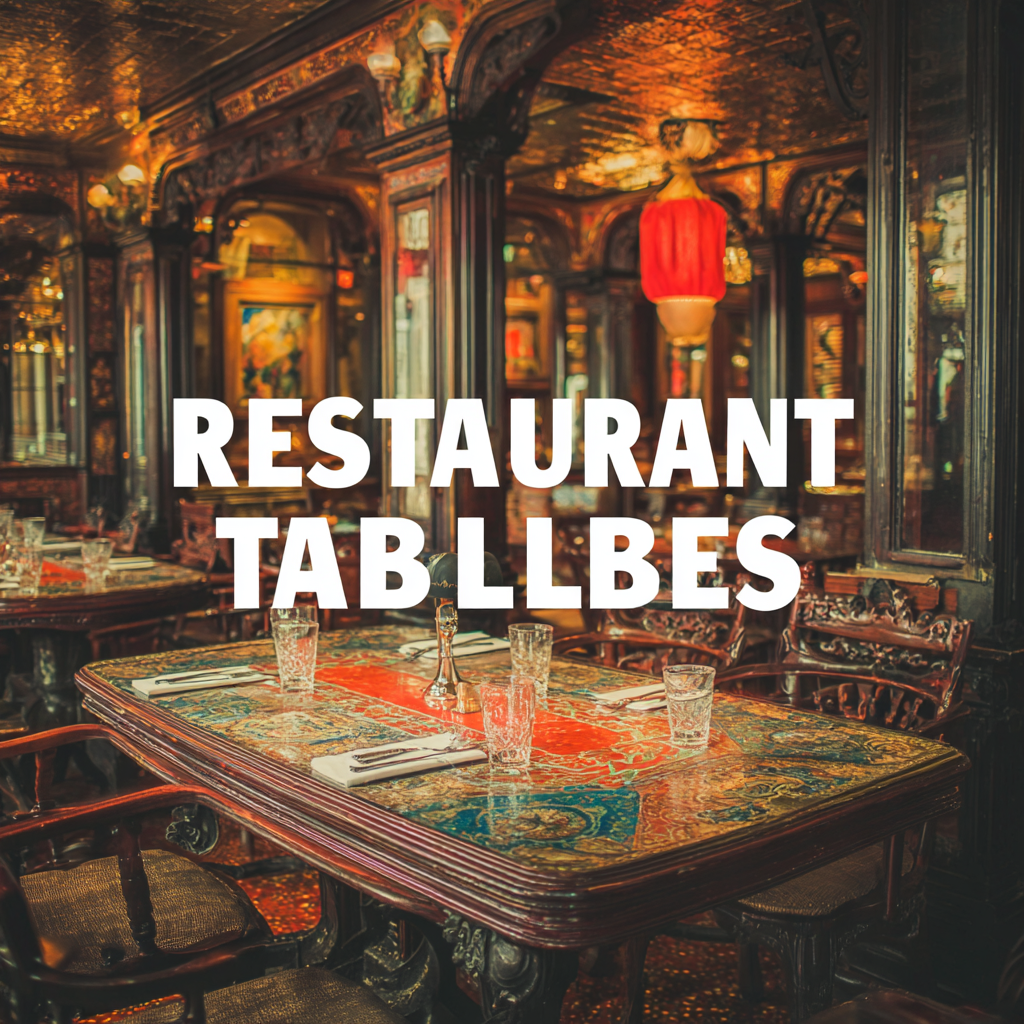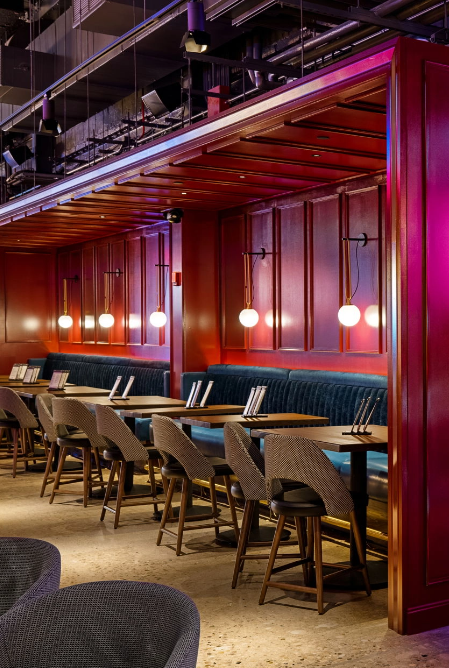As the dining landscape continues to evolve, the significance of well-designed restaurant tables has never been more pronounced. In the journey from China to global markets, the restaurant industry is undergoing a transformation that emphasizes not just food quality but also the overall dining experience. With the market projected for significant growth by 2025, restaurant tables are set to play a crucial role in shaping ambiance, fostering customer interaction, and enhancing satisfaction. This blog will delve into the pivotal trends and innovations surrounding restaurant tables, exploring how they can elevate dining experiences and contribute to the success of establishments in an increasingly competitive environment. From materials and design to functionality and adaptability, the right restaurant tables can create a lasting impression on patrons, making them an essential investment for restaurateurs looking to thrive in the global arena.

When it comes to creating a memorable dining experience, the quality of restaurant tables plays a crucial role. Research from the National Restaurant Association indicates that 76% of diners believe comfortable seating significantly enhances their overall dining experience. High-quality tables not only provide comfort but also contribute to the aesthetic appeal of the restaurant, establishing a lasting impression on customers. With restaurant design increasingly becoming a focal point of branding, investing in durable and stylish tables is essential for creating an inviting atmosphere that encourages patrons to return.

Moreover, the restaurant industry's focus on quality is reflected in its investment trends. According to a report by IBISWorld, the restaurant furniture market is projected to reach $5 billion by 2025, driven by demand for premium dining environments. Effective table design can also improve functionality, allowing for better space management and flow within the dining area. This not only boosts customer satisfaction but also enhances operational efficiency, ultimately leading to increased profitability. By prioritizing high-quality tables, restaurants can elevate the entire dining experience and differentiate themselves in today's competitive market.
In the evolving landscape of global dining experiences, the type of restaurant table can significantly impact customer satisfaction and overall ambiance. According to industry reports, the global restaurant furniture market is projected to reach USD 6.7 billion by 2025, emphasizing the demand for quality dining furnishings. Diverse dining styles require different table types, from intimate two-seaters for romantic dinners to communal tables designed for larger gatherings that encourage social interaction.

When selecting tables for varying dining experiences, consider the material and design. Wooden tables offer a warm and classic feel, while metal or glass options present a modern aesthetic. Additionally, height-adjustable tables are becoming increasingly popular, as they accommodate customers' changing needs and preferences.
Tips: Opt for round tables in cozy settings to facilitate conversation, and ensure adequate spacing between tables to promote a comfortable dining experience. Furthermore, consider the table height in relation to the seating to enhance comfort and accessibility. By thoughtfully choosing restaurant tables, establishments can elevate their customers' dining experience while catering to diverse styles and preferences.
The dining experience is an intricate tapestry woven from various elements, with restaurant tables playing a pivotal role in shaping ambiance and customer perception. According to a 2022 report from the National Restaurant Association, over 70% of diners consider the overall atmosphere, which includes furniture selection, when deciding where to eat. The choice of table—be it cozy two-tops or sprawling communal setups—can significantly influence how patrons perceive the establishment's style, comfort, and even food quality.
Research indicates that well-chosen tables enhance not just the aesthetic appeal but also the functionality of a restaurant. A study by Technomic revealed that 80% of diners prefer establishments that incorporate ergonomic designs into their tables, feeling more comfortable and willing to stay longer, potentially increasing their average spend. Furthermore, the type of table material and design can evoke different feelings; for instance, natural wood finishes tend to create a warm, inviting atmosphere, while sleek metal designs may convey sophistication and modernity.
As global dining trends evolve, recognizing the importance of restaurant tables in influencing customer experience is vital. With a carefully curated selection of tables, restaurateurs can strengthen their brand identity, enhance customer satisfaction, and ultimately drive sales in a competitive market.
In the competitive world of dining, the right restaurant tables can drastically influence the overall customer experience while also maximizing space efficiency. When selecting tables, it's essential to first consider the layout of your restaurant. Open floor plans allow for versatile table arrangements, while confined spaces require more strategic planning. Round tables are ideal for fostering conversation in smaller areas, while rectangular ones can accommodate larger parties without consuming too much room.
Additionally, the choice of materials plays a significant role in both aesthetics and function. Opting for lightweight, durable materials makes it easier to rearrange tables as needed, allowing for adaptability to different customer volumes and special events. Incorporating foldable or stackable options can further enhance space usage during peak hours. By thoughtfully integrating style, functionality, and flexibility, restaurant owners can create a welcoming ambiance that not only delights guests but also optimizes their operational space.
This chart illustrates the optimal table sizes for different restaurant layouts, showcasing how various dimensions can affect overall space efficiency.
In the quest for elevating dining experiences, modern restaurant tables play a pivotal role, not only in aesthetics but also in sustainability. Choosing furniture made from sustainable materials can significantly reduce a restaurant's environmental impact. For instance, tables crafted from reclaimed wood or bamboo not only add unique character to a restaurant's decor but also contribute to a circular economy by repurposing materials that would otherwise go to waste. Additionally, these materials are often sourced locally, which reduces the carbon footprint associated with transportation.
Moreover, the rise of eco-friendly manufacturing processes means that modern restaurant tables can be produced with minimal environmental degradation. Manufacturers are increasingly opting for non-toxic finishes and adhesives, ensuring that the tables do not release harmful chemicals into the environment. By investing in sustainable dining furniture, restaurants can align their brand with the values of environmentally conscious consumers, enhancing customer loyalty while promoting a cleaner planet. Embracing sustainable materials not only leads to stylish and functional dining spaces but also demonstrates a commitment to a greener future.
| Material Type | Environmental Impact | Durability (Years) | Cost (USD) | Aesthetic Appeal |
|---|---|---|---|---|
| Bamboo | Highly Renewable | 10-15 | 200-400 | Natural and Elegant |
| Recycled Plastic | Reduces Waste | 5-10 | 150-300 | Modern and Versatile |
| Reclaimed Wood | Saves Old Growth Forests | 20-30 | 300-600 | Rustic and Unique |
| Stainless Steel | Recyclable | 15-25 | 400-800 | Sleek and Modern |
| Concrete | Low Impact when Recycled | 30-50 | 500-1000 | Industrial and Strong |
©2024 Pine Vista LLC, DBA Design Manufacturing Group. All Rights Reserved.



©2024 Pine Vista LLC, DBA Design Manufacturing Group. All Rights Reserved.
